Jinsong Liu
Leveraging Convolutional Neural Network-Transformer Synergy for Predictive Modeling in Risk-Based Applications
Dec 24, 2024



Abstract:With the development of the financial industry, credit default prediction, as an important task in financial risk management, has received increasing attention. Traditional credit default prediction methods mostly rely on machine learning models, such as decision trees and random forests, but these methods have certain limitations in processing complex data and capturing potential risk patterns. To this end, this paper proposes a deep learning model based on the combination of convolutional neural networks (CNN) and Transformer for credit user default prediction. The model combines the advantages of CNN in local feature extraction with the ability of Transformer in global dependency modeling, effectively improving the accuracy and robustness of credit default prediction. Through experiments on public credit default datasets, the results show that the CNN+Transformer model outperforms traditional machine learning models, such as random forests and XGBoost, in multiple evaluation indicators such as accuracy, AUC, and KS value, demonstrating its powerful ability in complex financial data modeling. Further experimental analysis shows that appropriate optimizer selection and learning rate adjustment play a vital role in improving model performance. In addition, the ablation experiment of the model verifies the advantages of the combination of CNN and Transformer and proves the complementarity of the two in credit default prediction. This study provides a new idea for credit default prediction and provides strong support for risk assessment and intelligent decision-making in the financial field. Future research can further improve the prediction effect and generalization ability by introducing more unstructured data and improving the model architecture.
Reward Learning From Preference With Ties
Oct 05, 2024



Abstract:Reward learning plays a pivotal role in Reinforcement Learning from Human Feedback (RLHF), ensuring the alignment of language models. The Bradley-Terry (BT) model stands as the prevalent choice for capturing human preferences from datasets containing pairs of chosen and rejected responses. In preference modeling, the focus is not on absolute values but rather on the reward difference between chosen and rejected responses, referred to as preference strength. Thus, precise evaluation of preference strength holds paramount importance in preference modeling. However, an easily overlooked factor significantly affecting preference strength measurement is that human attitudes towards two responses may not solely indicate a preference for one over the other and ties are also a common occurrence. To address this, we propose the adoption of the generalized Bradley-Terry model -- the Bradley-Terry model with ties (BTT) -- to accommodate tied preferences, thus leveraging additional information. We prove that even with the access to the true distributions of prompt and response, disregarding ties can lead to a notable bias in preference strength measurement. Comprehensive experiments further validate the advantages of incorporating ties in preference modeling. Notably, fine-tuning with BTT significantly outperforms fine-tuning with BT on synthetic preference datasets with ties, labeled by state-of-the-art open-source LLMs.
Rapid hyperspectral photothermal mid-infrared spectroscopic imaging from sparse data for gynecologic cancer tissue subtyping
Feb 28, 2024



Abstract:Ovarian cancer detection has traditionally relied on a multi-step process that includes biopsy, tissue staining, and morphological analysis by experienced pathologists. While widely practiced, this conventional approach suffers from several drawbacks: it is qualitative, time-intensive, and heavily dependent on the quality of staining. Mid-infrared (MIR) hyperspectral photothermal imaging is a label-free, biochemically quantitative technology that, when combined with machine learning algorithms, can eliminate the need for staining and provide quantitative results comparable to traditional histology. However, this technology is slow. This work presents a novel approach to MIR photothermal imaging that enhances its speed by an order of magnitude. Our method significantly accelerates data collection by capturing a combination of high-resolution and interleaved, lower-resolution infrared band images and applying computational techniques for data interpolation. We effectively minimize data collection requirements by leveraging sparse data acquisition and employing curvelet-based reconstruction algorithms. This method enables the reconstruction of high-quality, high-resolution images from undersampled datasets and achieving a 10X improvement in data acquisition time. We assessed the performance of our sparse imaging methodology using a variety of quantitative metrics, including mean squared error (MSE), structural similarity index (SSIM), and tissue subtype classification accuracies, employing both random forest and convolutional neural network (CNN) models, accompanied by ROC curves. Our statistically robust analysis, based on data from 100 ovarian cancer patient samples and over 65 million data points, demonstrates the method's capability to produce superior image quality and accurately distinguish between different gynecological tissue types with segmentation accuracy exceeding 95%.
Stochastic Dimension-reduced Second-order Methods for Policy Optimization
Jan 28, 2023Abstract:In this paper, we propose several new stochastic second-order algorithms for policy optimization that only require gradient and Hessian-vector product in each iteration, making them computationally efficient and comparable to policy gradient methods. Specifically, we propose a dimension-reduced second-order method (DR-SOPO) which repeatedly solves a projected two-dimensional trust region subproblem. We show that DR-SOPO obtains an $\mathcal{O}(\epsilon^{-3.5})$ complexity for reaching approximate first-order stationary condition and certain subspace second-order stationary condition. In addition, we present an enhanced algorithm (DVR-SOPO) which further improves the complexity to $\mathcal{O}(\epsilon^{-3})$ based on the variance reduction technique. Preliminary experiments show that our proposed algorithms perform favorably compared with stochastic and variance-reduced policy gradient methods.
Leveraging high-resolution spatial features in mid-infrared spectroscopic imaging to classify tissue subtypes in ovarian cancer
May 19, 2022

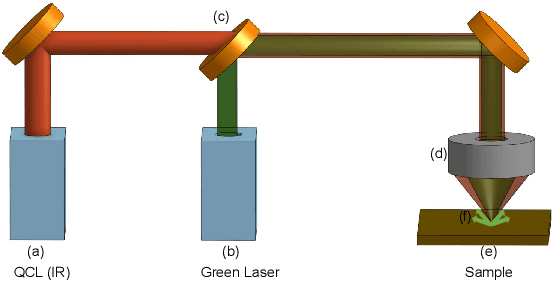

Abstract:Mid-infrared spectroscopic imaging (MIRSI) is an emerging class of label-free techniques being leveraged for digital histopathology. Optical photothermal infrared (O-PTIR) is based on vibrational absorbance imaging using a pump-probe architecture capable of a 10x enhancement in spatial resolution relative to FTIR imaging. This allows truly sub-cellular spectroscopic investigation of tissue at biochemically important fingerprint wavelengths. Modern histopathologic identification of ovarian cancer involves tissue staining followed by morphological pattern recognition. This process is time-consuming, subjective, and requires extensive expertise. In this paper, we present the first label-free automated histological classification of ovarian tissue sub-types using MIRSI. We demonstrate that enhanced resolution of sub-cellular features, combined with spectroscopic information, enables reliable classification (0.98 AUC) of ovarian cell sub-types. Moreover, we present statistically robust validation from 74 patient samples with over 60 million data points. This demonstrates that sub-cellular resolution from five wavenumbers is sufficient to outperform state-of-the-art diffraction-limited techniques from up to 374 different wavenumbers. O-PTIR also performs measurements in back-reflection geometry, opening the door to future in vivo studies on glass slides.
Patch-based Fake Fingerprint Detection Using a Fully Convolutional Neural Network with a Small Number of Parameters and an Optimal Threshold
Mar 21, 2018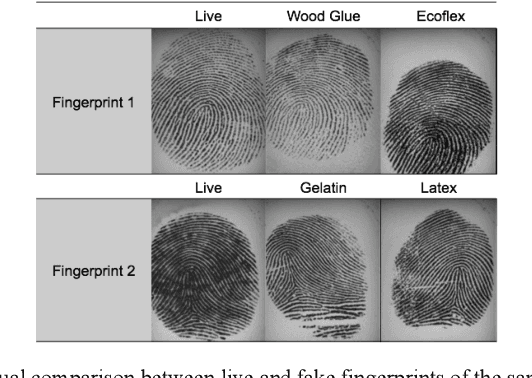
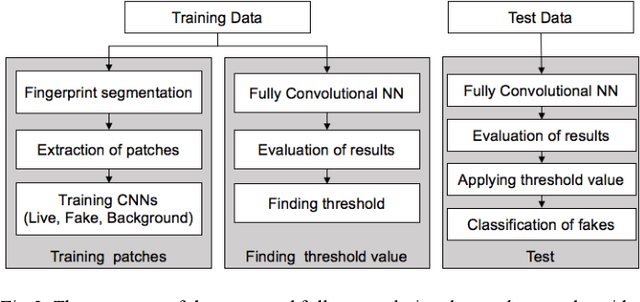
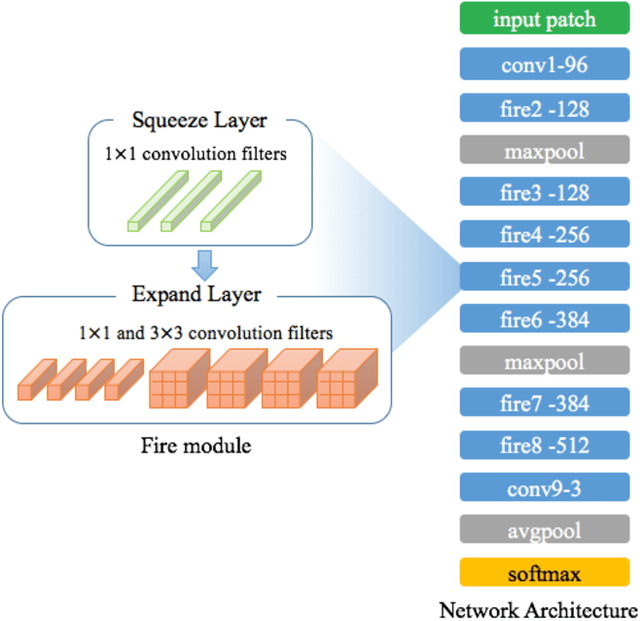
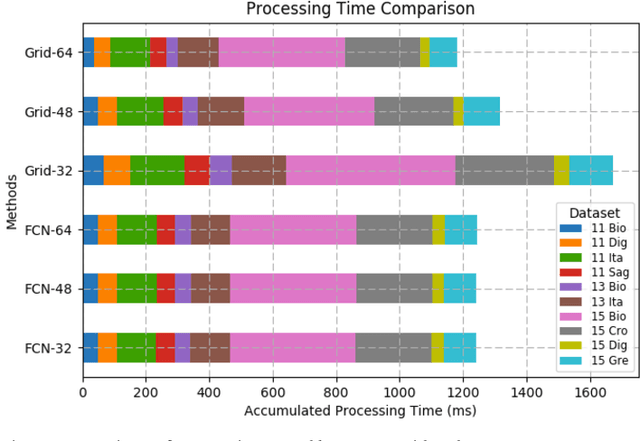
Abstract:Fingerprint authentication is widely used in biometrics due to its simple process, but it is vulnerable to fake fingerprints. This study proposes a patch-based fake fingerprint detection method using a fully convolutional neural network with a small number of parameters and an optimal threshold to solve the above-mentioned problem. Unlike the existing methods that classify a fingerprint as live or fake, the proposed method classifies fingerprints as fake, live, or background, so preprocessing methods such as segmentation are not needed. The proposed convolutional neural network (CNN) structure applies the Fire module of SqueezeNet, and the fewer parameters used require only 2.0 MB of memory. The network that has completed training is applied to the training data in a fully convolutional way, and the optimal threshold to distinguish fake fingerprints is determined, which is used in the final test. As a result of this study experiment, the proposed method showed an average classification error of 1.35%, demonstrating a fake fingerprint detection method using a high-performance CNN with a small number of parameters.
 Add to Chrome
Add to Chrome Add to Firefox
Add to Firefox Add to Edge
Add to Edge